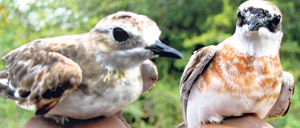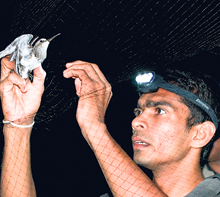Only the moon and thousands of stars light the Bundala sky. The strong breeze across the mudflats is tinged with salt. The calm of the night is soon disturbed by a faint flutter. A Little Stint that is entangled in the mist-net is struggling hard to break free.
A member of the bird-ringing team skilfully extricates the bird from the net and puts it into a cloth pouch so that it can be taken to their temporary camp set up nearby. Once all the nets are checked, the light of the petromax lamps is increased and the bird ringers start their ringing operation. Each bird is given a number and its data is recorded in a fresh data sheet. Later this information goes into a computerized central database.
The bird ringing camp was conducted as part of the National Bird Ringing Programme (NBRP) at Bundala National Park. Aimed at monitoring Migratory Shorebirds this was initiated by the Field Ornithology Group of Sri Lanka (FOGSL) in collaboration with the Department of Wildlife Conservation (DWLC) in 2005.
The winter visitors have already started arriving and this is the third ringing session for 2008.
“This redshank needs a Grade B ring,” says a bird ringer holding a Common Redshank. The metal rings used to mark migrant birds come in different sizes. Each ring has its own number and a return address including the name of organization and country engraved on it. This number is recorded along with other details of the bird like the size of the beak, total length, weight etc.
The ringer swiftly places the ring on bird’s leg. A little adjustment with a pair of pliers seals the ring around the bird’s leg. Several large boxes are tagged with the names of different birds and the birds are placed in them.
“We keep the birds overnight to complete the processing in the morning. Recording the birds’ moulting patterns and colours needs more natural light. By the dim light of the lamps, we can’t see the colours properly,” explains Chinthaka Kaluthota, leader of the National Bird Ringing Programme.
The Bundala lagoon is a paradise for migrant shorebirds; hence the best place for a ringing camp. Of the 197 species of birds observed in Bundala, 58 are migratory species. It is believed the shallow wetlands at Bundala provide a vast area of feeding and roosting grounds for large flocks of migratory shorebirds.
The capturing of birds for ringing starts at dusk by setting up mist nets across the Bundala lagoon. A mist net is a net made of thin strings with small holes that are virtually invisible to a bird in full flight. At least four mist nets are set up at different locations of Bundala lagoon and kept open throughout the night. Nets are monitored every 30 minutes to check for a catch. Once caught in the net, the bird struggles to get free and gets further entangled. Disentangling a bird from a mist net can be difficult and must be done carefully only by trained personnel.
 |
| Setting up mist nets in the Bundala lagoon |
If a bird is heavily tangled, the mist net is cut to avoid injuring the bird.
The most commonly captured species of birds at Bundala are Little stints, Kentish plovers, Curlew sandpipes, Lesser Sandplovers and Common redshanks. “Not having a proper set of data is a drawback in conserving migratory birds. That is why we needed a National Bird Ringing Programme,” said Prof. Sarath Kotagama, National coordinator who initiated this ringing programme through FOGSL. Four ringing sessions are carried out each year of which three are during the migratory season while the other is in July –the non-migratory period.
FOGSL has also trained Department of Wildlife and Conservation (DWLC) field officers on bird ringing to make sure the project proceeds without disruption.
Sri Lanka being a signatory to the International Convention on Migratory Species, the Department plans to take the National Bird Ringing Programme forward. |



